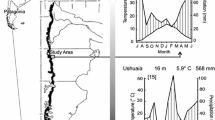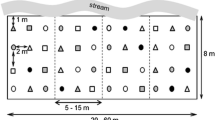Abstract
Understanding the factors controlling tree seedling recruitment is an integral research priority for savanna ecosystems, particularly for the management of woody plant encroachment. We investigated the effects of increased nutrients, fire and grazing on the survival, growth and biomass of Acacia sieberiana using a completely randomized experimental design in the greenhouse. We simulated a typical savanna microhabitat by planting a common savanna grass species, Eragrostis curvula, with seedlings of A. sieberiana. The trees and grasses were allowed to establish for 12 weeks. Thereafter, treatments of fertilizer (100 kg N/ha), simulated grazing and fire were applied. Weekly measurements of relative growth rate (RGRheight and RGRdiameter) were recorded. At the end of 24 weeks, survival, total above- and below-ground biomass, and key functional traits of the trees (specific leaf area and average thorn length) were recorded to assess differences in tree performance. We found that fertilization was beneficial to the grass only, increasing their total biomass. While, the direct removal of grass biomass by grazing in our study revealed no main (statistical) effect on tree seedling growth, we observed decreased survival of tree seedlings with higher grass biomass. Fire increased the tree seedlings’ investment in shoot growth and stem diameter. However, in the absence of grass competition, there were no differences in the post-fire allocation of the resprouting tree seedlings. Higher grass biomass was found to result in decreased specific leaf area of tree seedlings. We conclude that grass competition is important for controlling the encroachment of A. sieberiana.




Similar content being viewed by others
References
Aerts R, Boot RGA, van der Aart PJM (1991) The relation between above- and belowground biomass allocation patterns and competitive ability. Oecologia 87:551–559
Aranda MJ, Tognetti PM, Mazía N (2015) Grass competition surpasses the effect of defoliation on a woody plant invader. Acta Oecol 68:37–42
Augustine DJ, McNaughton SJ (2004) Regulation of shrub dynamics by native browsing ungulates on East African rangeland. J Appl Ecol 41:45–58
Balfour DA, Midgley JJ (2006) Fire-induced stem death in an African Acacia is not caused by canopy scorching. Austral Ecol 31:892–896
Balfour DA, Midgley JJ (2008) A demographic perspective on bush encroachment by Acacia karroo in Hluhluwe-Imfolozi Park, South Africa. Afr J Range For Sci 25:147–151
Bond WJ (2008) What limits trees in C4 grasslands and savannas? Annu Rev Ecol Evol Syst 39:641–659
Bond WJ, Keeley JE (2005) Fire as a global ‘herbivore’: the ecology and evolution of flammable ecosystems. Trends Ecol Evol 20:387–394
Bond WJ, Midgley GF (2000) A proposed CO2 mechanism of woody plant invasion in grasslands and savannas. Glob Change Biol 6:865–869
Bond WJ, Midgley JJ (2001) Ecology of sprouting in woody plants: the persistence niche. Trends Ecol Evol 16:45–51
Busso CA, Briske DD, Olalde-Portugal V (2001) Root traits associated with nutrient exploitation following defoliation in three coexisting perennial grasses in a semi-arid savanna. Oikos 93:332–342
Charles-Dominique T, Midgley GF, Bond WJ (2017) Fire frequency filters species by bark traits in a savanna–forest mosaic. J Veg Sci 28:728–735
Clarke PJ, Lawes MJ, Midgley JJ, Lamont BB, Ojeda F, Burrows GE, Enright NJ, Knox KJE (2013) Resprouting as a key functional trait: how buds, protection and resources drive persistence after fire. New Phytol 197:19–35
Coates-Palgrave M (2002) Keith Coates-Palgrave’s trees of southern Africa. Struik, Cape Town
Cornelissen JHC, Lavorel S, Garnier E, Diaz S, Buchmann N, Gurvich DE, Reich PB, Ter Steege H, Morgan HD, Van Der Heijden MGA, Pausas JG, Poorter H (2003) A handbook of protocols for standardised and easy measurement of plant functional traits worldwide. Aust J Bot 51:335–380
Cramer MD, Van Cauter A, Bond WJ (2010) Growth of N2-fixing African savanna Acacia species is constrained by below-ground competition with grass. J Ecol 98:156–167
February EC, Higgins SI, Bond WJ, Swemmer L (2013) Influence of competition and rainfall manipulation on the growth responses of savanna trees and grasses. Ecology 94:1155–1164
Friend AL, Coleman MD, Isebrands JG (1994) Carbon allocation to root and shoot systems of woody plants. In: Davis TD, Haissig BE (eds) Biology of adventitious root formation. Plenum Publishing Corporation, New York, pp 245–273
Goldberg DE, Fleetwood L (1987) Competitive effect and response in four annual plants. J Ecol 75:1131–1143
Goldberg DE, Landa K (1991) Competitive effect and response: hierarchies and correlated traits in the early stages of competition. J Ecol 79:1013–1030
Grellier S, Barot S, Janeau JL, Ward D (2012) Grass competition is more important for Acacia recruitment than seed ingestion by livestock. Plant Ecol 213:899–908
Grellier S, Ward D, Janeau JL, Podwojewski P, Lorentz S, Abbadie L, Valentin C, Barot S (2013) Positive versus negative environmental impacts of tree encroachment in South Africa. Acta Oecol 53:1–10
Grime JP (1977) Evidence for the existence of three primary strategies in plants and its relevance to ecological and evolutionary theory. Am Nat 111:1169–1194
Hean J, Ward D (2012) Fire and herbivory are not substitutable: evidence from regrowth patterns and changes in physical and chemical defences in Acacia seedlings. J Veg Sci 23:13–23
Higgins SI, Bond WJ, Trollope WSW (2000) Fire, resprouting and variability: a recipe for grass-tree coexistence in savanna. J Ecol 88:213–229
Higgins SI, Bond WJ, February EC, Bronn A, Euston-Brown DIW, Enslin B, Govender N, Rademan L, O’Regan S, Potgieter ALF, Scheiter S, Sowry R, Trollope L, Trollope WSW (2007) Effects of four decades of fire manipulation on woody vegetation structure in savanna. Ecology 88:1119–1125
Kambatuku J, Cramer M, Ward D (2013) Nitrogen fertilisation reduces grass-induced N2 fixation of tree seedlings from semi-arid savannas. Plant Soil 365:307–320
Kgope BS, Bond WJ, Midgley GF (2010) Growth responses of African savanna trees implicate atmospheric [CO2] as a driver of past and current changes in savanna tree cover. Austral Ecol 35:451–463
Kohi EM, de Boer FW, Slot M, van Wieren SE, Ferwerda JG, Grant RC, Heitkonig IMA, de Knegt HJ, van der Waal C, Prins HHT (2009) Effects of simulated browsing on growth and leaf chemical properties in Colophospermum mopane saplings. Afr J Ecol 48:190–196
Kraaij T, Ward D (2006) Effects of rain, nitrogen, fire and grazing on tree recruitment and early survival in bush-encroached savanna, South Africa. Plant Ecol 186:235–246
Lawes MJ, Adie H, Russell-Smith J, Murphy B, Midgley JJ (2011) How do small savanna trees avoid stem mortality by fire? The roles of stem diameter, height and bark thickness. Ecosphere 2: art42. https://doi.org/10.1890/es10-00204.1
Lawes MJ, Midgley JJ, Clarke PJ (2013) Costs and benefits of relative bark thickness in relation to fire damage: a savanna/forest contrast. J Ecol 101:517–524
Lessin LM, Dyer AR, Goldberg DE (2001) Using upper boundary constraints to quantify competitive response of desert annuals. Oikos 92:153–159
McConnaughay KDM, Bazzaz FA (1991) Is physical space a soil resource? Ecology 72:94–103
Meyer KM, Wiegand K, Ward D, Moustakas A (2007) SATCHMO: a spatial simulation model of growth, competition, and mortality in cycling savanna patches. Ecol Model 209:377–391
Midgley JJ, Bond WJ (2001) A synthesis of the demography of African Acacias. J Trop Ecol 17:871–886
Morrison TA, Holdo RM, Rugemalila DM, Nzunda M, Anderson TM (2019) Grass competition overwhelms effects of herbivores and precipitation on early tree establishment in Serengeti. J Ecol 107:216–228
Pérez-Harguindeguy N, Díaz S, Garnier E, Lavorel S, Poorter H, Jaureguiberry P, Bret-Harte MS, Cornwell WK, Craine JM, Gurvich DE, Urcelay C, Veneklaas EJ, Reich PB, Poorter L, Wright IJ, Ray P, Enrico L, Pausas JG, de Vos AC, Buchmann N, Funes G, Quétier F, Hodgson JG, Thompson K, Morgan HD, ter Steege H, Sack L, Blonder B, Poschlod P, Vaieretti MV, Conti G, Staver AC, Aquino S, Cornelissen JHC (2016) Corrigendum to: new handbook for standardised measurement of plant functional traits worldwide. Aust J Bot 64:715–716
Phoenix GK, Hicks WK, Cinderby S, Kuylenstierna JC, Stock WD, Dentener FJ, Giller KE, Austin AT, Lefroy RD, Gimeno BS (2006) Atmospheric nitrogen deposition in world biodiversity hotspots: the need for a greater global perspective in assessing N deposition impacts. Glob Change Biol 12:470–476
Pillay T, Ward D (2014) Competitive effect and response of savanna tree seedlings: comparison of survival, growth and associated functional traits. J Veg Sci 25:226–234
Plas F, Howison R, Reinders J, Fokkema W, Olff H (2013) Functional traits of trees on and off termite mounds: understanding the origin of biotically-driven heterogeneity in savannas. J Veg Sci 24:227–238
Reich PB, Wright IJ, Cavender-Bares J, Craine JM, Oleksyn J, Westoby M, Walters MB (2003) The evolution of plant functional variation: traits, spectra, and strategies. Int J Pl Sci 164:S143–S164
Sabiiti EN, Wein RW (1987) Fire and Acacia seeds: a hypothesis of colonization success. J Ecol 74:937–946
Sankaran M, Hanan NP, Scholes RJ, Ratnam J, Augustine DJ, Cade BS, Gignoux J, Higgins SI, Le Roux X, Ludwig F, Ardo J, Banyikwa F, Bronn A, Bucini G, Caylor KK, Coughenour MB, Diouf A, Ekaya W, Feral CJ, February EC, Frost PGH, Hiernaux P, Hrabar H, Metzger KL, Prins HHT, Ringrose S, Sea W, Tews J, Worden J, Zambatis N (2005) Determinants of woody cover in African savannas. Nature 438:846–849
Schutz A, Cramer MD, Bond WJ (2009) Juggling carbon: allocation patterns of a dominant tree in a fire-prone savanna. Oecologia 160:235–246
Stevens N, Lehmann CE, Murphy BP, Durigan G (2017) Savanna woody encroachment is widespread across three continents. Glob Change Biol 23:235–244
Suding KN, Goldberg DE, Hartmann KM (2003) Relationships among species traits: separating levels of response and identifying linkages to abundance. Ecology 84:1–16
Tedder M, Kirkman K, Morris C, Fynn R (2014) Tree–grass competition along a catenal gradient in a mesic grassland, South Africa. Grassl Sci 60:1–8
Tjelele J, Ward D, Dziba L (2015) The effects of seed ingestion by livestock, dung fertilization, trampling, grass competition and fire on seedling establishment of two woody plant species. PLoS ONE 10:e0117788. https://doi.org/10.1371/journal.pone.0117788
Vadigi S, Ward D (2012) Fire and nutrient gradient effects on the sapling ecology of four Acacia species in the presence of grass competition. Plant Ecol 213:1793–1802
Vadigi S, Ward D (2013) Shade, nutrients, and grass competition are important for tree sapling establishment in a humid savanna. Ecosphere 4:e142. https://doi.org/10.1890/ES13-00239.1
Vadigi S, Ward D (2014) Herbivory effects on saplings are influenced by nutrients and grass competition in a humid South African savanna. Perspect Plant Ecol Evol Syst 16:11–20
Vilá M (1997) Effect of root competition and shading on resprouting dynamics of Erica multiflora L. J Veg Sci 8:71–80
Violle C, Jiang L (2009) Towards a trait-based quantification of species niche. J Plant Ecol 2:87–93
Wakeling J, Bond W, Ghaui M, February E (2015) Grass competition and the savanna-grassland ‘treeline’: a question of root gaps? S Afr J Bot 101:91–97
Ward D (2005) Do we understand the causes of bush encroachment in African savannas? Afr J Range For Sci 22:101–105
Ward D, Esler KJ (2011) What are the effects of substrate and grass removal on recruitment of Acacia mellifera seedlings in a semi-arid environment? Plant Ecol 212:245–250
Wiegand K, Saltz D, Ward D (2006) A patch-dynamics approach to savanna dynamics and woody plant encroachment—insights from an arid savanna. Perspect Plant Ecol Evol Syst 7:229–242
Wigley B, Cramer MD, Bond WJ (2009) Sapling survival in a frequently burnt savanna: mobilisation of carbon reserves in Acacia karroo. Plant Ecol 203:1–11
Woods SR, Archer SR, Schwinning S (2014) Seedling responses to water pulses in shrubs with contrasting histories of grassland encroachment. PLoS ONE 9:e87278
Acknowledgements
We would like to thank the National Research Foundation Grant No. 90448 for supporting this study, and the technical staff (Welcome Ncgobo and Alison Young) at the University of KwaZulu-Natal for help with plant harvesting and data collection. We are also grateful to Admore Mureva and Desale Y. Okubamichael for their valuable contributions.
Author information
Authors and Affiliations
Corresponding author
Additional information
Communicated by Marjan Jongen.
Publisher's Note
Springer Nature remains neutral with regard to jurisdictional claims in published maps and institutional affiliations.
Rights and permissions
About this article
Cite this article
Pillay, T., Ward, D. Grass competition is more important than fire for suppressing encroachment of Acacia sieberiana seedlings. Plant Ecol 222, 149–158 (2021). https://doi.org/10.1007/s11258-020-01094-1
Received:
Accepted:
Published:
Issue Date:
DOI: https://doi.org/10.1007/s11258-020-01094-1




